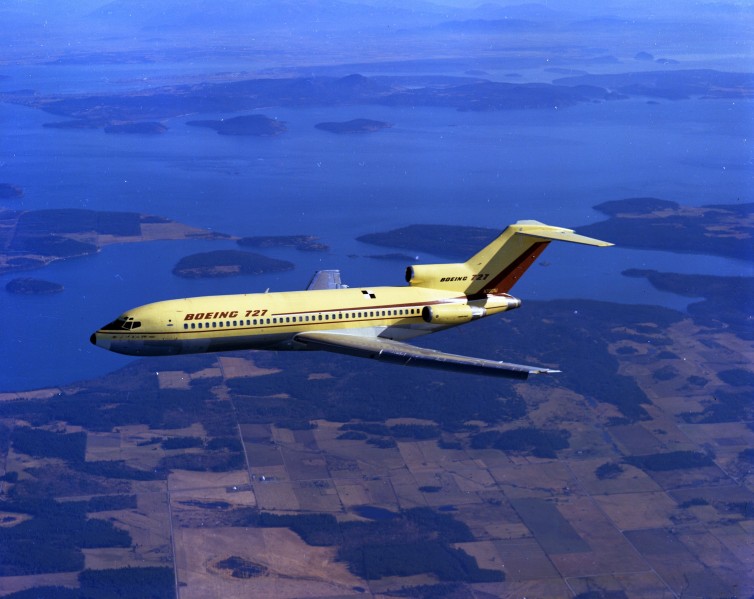
Air-to-air photo of the Boeing 727’s first flight – Photo: Boeing
Today is the 53rd anniversary of the Boeing 727’s first flight. What a day. At the time, the 727 was a risk and important to the success of Boeing. Luckily for everyone, not only was the first flight a huge success, but the aircraft would go on to help redefine domestic air travel.
Its three iconic engines also helped to build aviation fans around the world; it is still a favorite among AvGeeks today.
BONUS: An AvGeek in the left seat – flying the Boeing 727
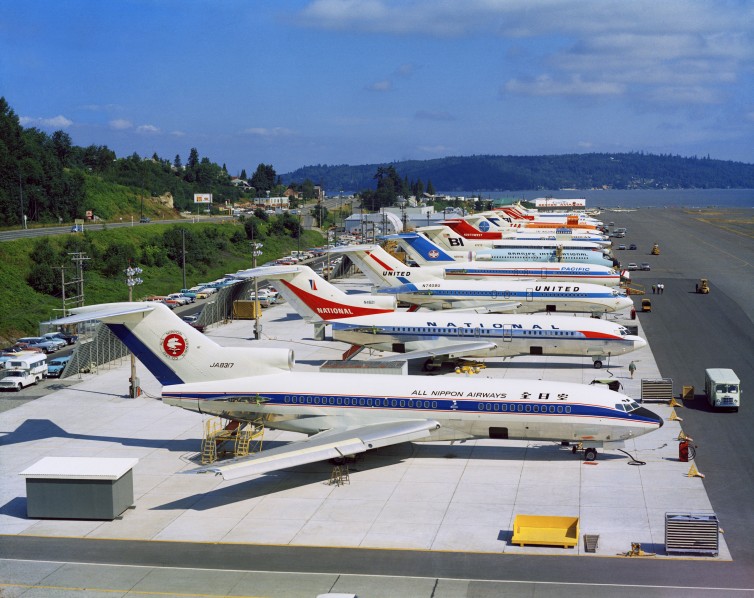
727 Renton flight line in 1966 – Photo: Boeing
To help celebrate the first flight’s anniversary, we reached out to Boeing to see if we could get some photos, and they delivered! We were told that some “haven’t seen the light of day in 50 years.” Rock on!
BONUS: VIDEO – A tribute to the Boeing 727
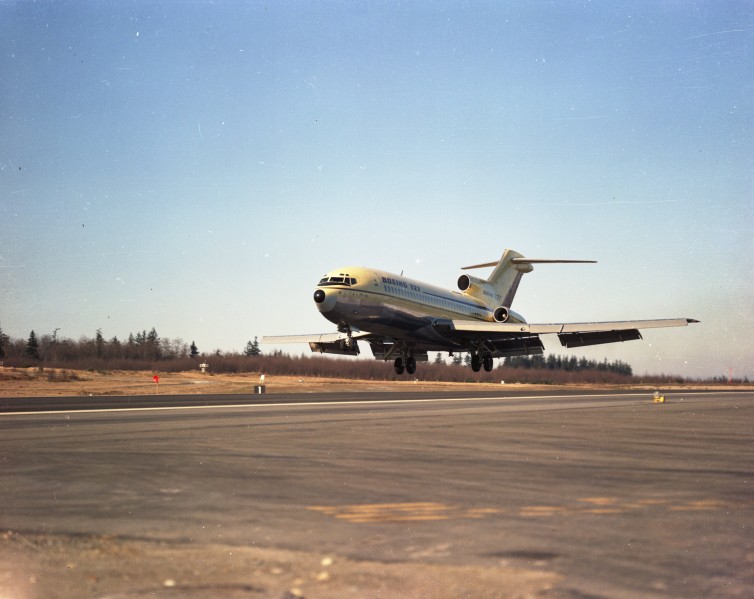
The first landing of N7001U at Paine Field on February 9, 1963 – Photo: Boeing
The first 727 (registration N7001U) rolled out of the Boeing factory on November 27, 1962 and took flight (from Renton Field to Paine Field) on February 9, 1963. It was then used for a year as a Boeing test flight aircraft before being delivered to United Airlines on October 6, 1964.
BONUS: The first Boeing 727 prepares for its last Flight
With United, it flew 64,495 hours, with 48,060 takeoffs and landings. After being repainted to its original livery, N7001U flew in January 1991 from Boeing Field to Paine Field, where it has been sitting ever since.
- The first Boeing 727 – Photo: Boeing
- Flying over the Pacific Northwest – Photo: Boeing
- Flying low, gear down – Photo: Boeing
’œThe 727 is an amazing story and a lesson for us today,” Michael Lombardi, corporate historian with The Boeing Company, explained to AirlineReporter. “The tri-jet was developed under crushing adversity and the decision to go forward was seen as a tremendous financial risk.”
BONUS: Interior photo tour of the first Boeing 727
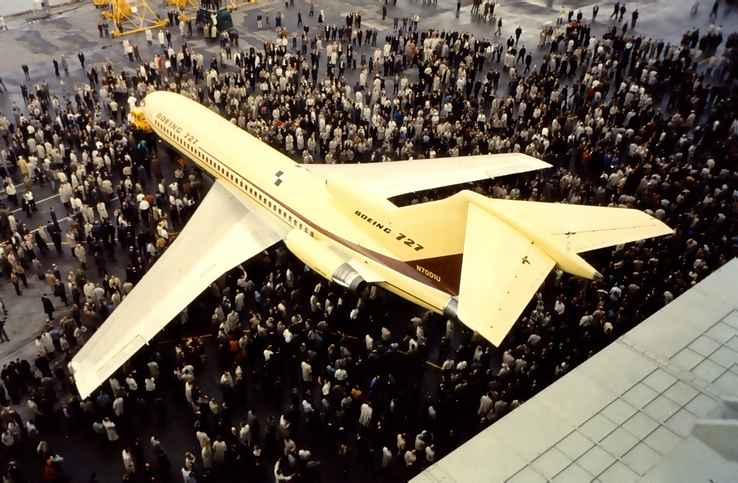
Rollout of E1 (N7001U) from Boeing’s Renton Plant on November 27, 1962 – Photo: Bob Bogash
“Here we are more than thirty years after the last one rolled off the line it is still one of the best selling commercial jets in history,” Lombardi continued.
“The credit goes to Boeing President Bill Allen for accepting the risk and trusting his team, but more so to that team, lead by Jack Steiner who firmly believed that his people were capable of far greater accomplishments if they were stimulated by goals that they recognized as almost unachievable and kept them focused on designing the right airplane for the market.” And… they nailed it.
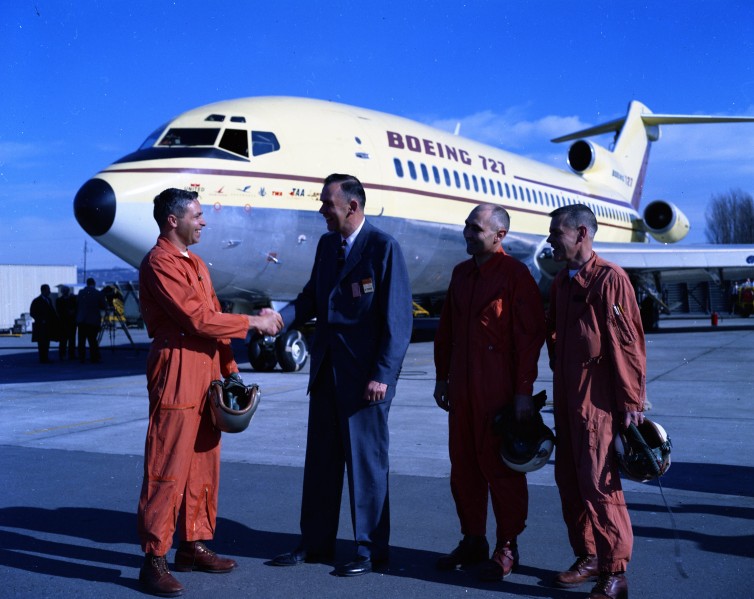
The Boeing 727’s first flight – Photo: Boeing
Boeing was initially planning to build about 250 of the 727. But a total of 1,832 were built until production halted in 1984. For some perspective, (McDonnell) Douglas built 976 DC-9 aircraft, and the Boeing 707 did 1,010.
Even today, the 727 is still flying. Some with cargo, charter airlines, private jets, and a few airlines you probably have never heard of.
- A United Boeing 247 is currently parked next to the first 727
- Close up of the first Boeing 727 cockpit
- The first Boeing 727 sitting at Paine Field
As we celebrate the first 727’s first flight, we also prepare for the aircraft’s final flight. It has been sitting at the Museum of Flight’s Restoration Center at Paine Field for a long time. It has slowly been restored to flight-worthy condition. Although many have thought this would never happen, the final flight is just around the corner. Lots of people are excited to see it once again take to the skies, especially one particular pilot.
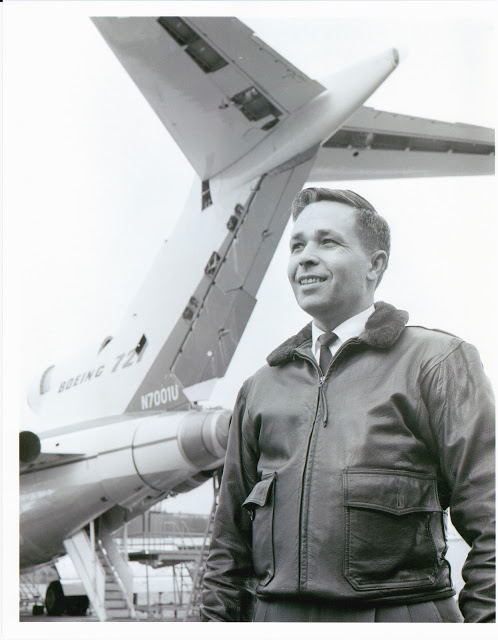
Lew, taken with N7001U the day before first flight – Photo: Boeing
“I think from a pilot’s perspective, it is interesting to note Lew Wallick’s comment that of all the Boeing projects he worked on, he was most proud being the Chief Test Pilot on the 727,” Tim Powell, current 727 pilot and the one set to fly N7001U’s final flight, told AirlineReporter. “With Lew honing the flight characteristics of the 727 and it being the first Boeing airliner with all-hydraulic-powered flight controls, that aircraft is truly a pilot’s airplane!”
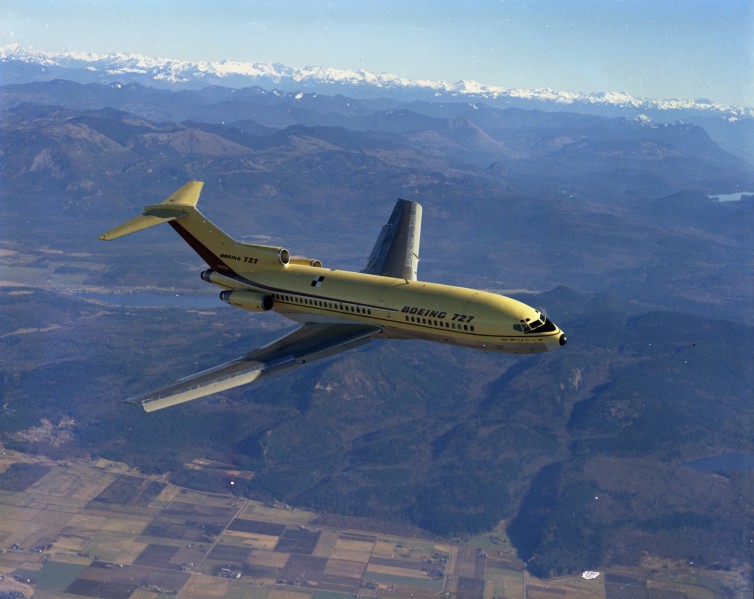
The Boeing 727’s first flight – Photo: Boeing
Really, thanks goes to the amazing people who have been working on the project for so many years. Their passion, dedication, and love for this plane are immeasurable. Be sure to keep up with the current status of the 727’s final flight and when it does fly, we will be watching and sharing here and via our Twitter account.
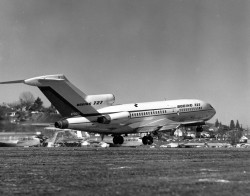
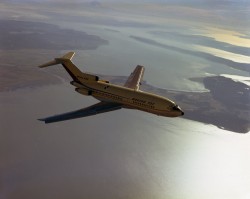
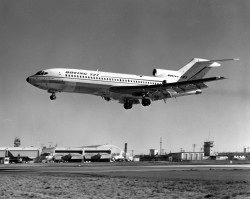
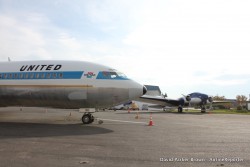
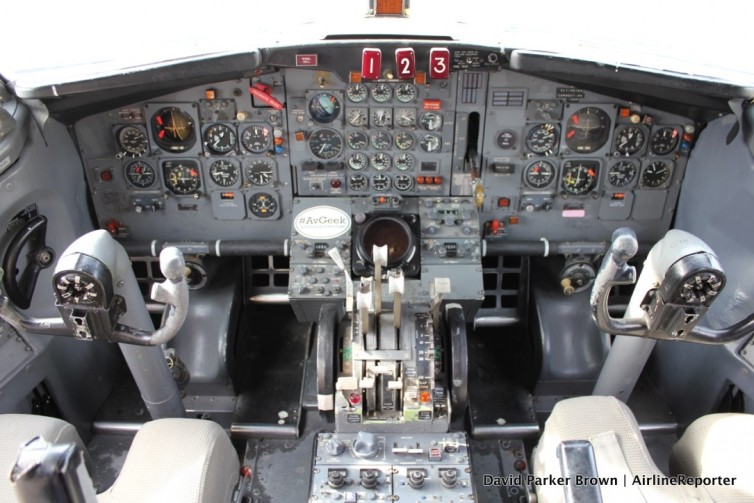
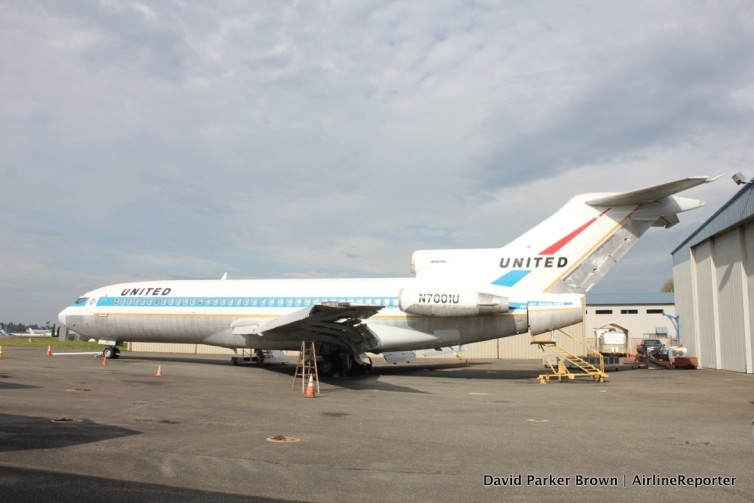
David,
Thanks for another great story! I have flown as a passenger 136 times on the various versions of the B727 with United, American, Northwest, Pan Am, USAir, Continental, Republic, Air One, Eastern, Braniff, TWA, Air Canada, Piedmont and Delta Airlines. Good memories from a time when almost all middle seats on the B727 were empty!
James Klansnic was DB Cooper
I loved flying in the 727!
It was unique in many ways, not the least having the rear stairway!
The first one I flew on was as a teenager, in 1968, was VH-TJD, the ‘Gregory Blaxland’, owned by TAA.
My last flight on one, from Darwin to Adelaide, in 1996, owned by Ansett.
Like the beautiful Boeing 767’s, they’re sadly missed, I think, by many!
Surely one of the most beautiful airplanes you can get. The back staircase, the three jet engines at he back of the plane and the most awesome part, the T rudder or what do the experts call it. SAA had six of them, all of them out of service.
The only disadvantage about these airplanes was, that they were very noisy.
Thank you David for a very good article which make “older” air crew longing back to those days.
I get booked on a 727 once or twice a year with Iran Air and Aseman Airlines. It’s something special really. Now that they have access to the markets again they’ll probably retire them, though no ones exactly upset but it was nice to be able to fly some retro planes (727-200adv, 707s, 747SP&100, 733-200 & etc. regularly)
Many pleasant memories of the B-727, here. In the mid-to-late 1970s, I commuted LAX-SFO too frequently, most often riding the B-727-200 operated by PSA. (Often at least every hour during the majority of the day.) In its day, it was a comfortable, very reliable airplane and, and another commenter notes, most middle seats were vacant. Nice story and some nice pix from Boeing. -C.
I was lucky enough to go to work for Boeing in 1969 after I graduated from college with a degree in aerospace engineering. I was even luckier when I ended up as an aeronautical engineer in Mark Gregoire’s group “727 Aero” where the 727 was still being improved. The 727 was, and still is, my favorite airplane of all time, and I suppose everyone knows that the first 727 is now being readied to fly from Paine Field down the The Museum of Flight in Seattle. Beautiful, wonderful airplane!
One of the best aircraft in terms of maintenance accessibility, I have worked in the times of VASP brazilian airline between 1979 and 1988. The launch of the epoch of the series, B-727- 200 was the most beautiful aircraft between airports. Unfortunately the cost of fuel to travel away from Brazil.
I operated the B727 as a professional Flight Engineer for 24 and a half years with Ansett Australia. I am claiming that as a world record………. In Australia you had to be a Licenced Aircraft Maintenance Engineer to graduate to be a Flight Engineer. Operated the 727-100, 727-100QC, 727-200 and 727-200LR. Best years of my life.
C.J.Ugalde
As a Mexicana’s pilot this airplane , awesome.
Thank you for another wonderful article! I get goose bumps seeing these photos of my father Lew Wallick and his favorite airplane, the 727. I’m excited to be at Boeing Field to watch the prototype make its final landing so that it can be put on permanent display at the Museum of Flight.
An historic tidbit: On August 14, 1984 the last 727 produced rolled out with the original flight crew in attendance. Two weeks later – and three months after my father’s 60th birthday, which under FAA rules at the time disqualified him from flying test flights for Boeing – John Cashman was captain of the first flight of that final 727, built for FedEx; Paul Leckman was co-pilot. My father, Chief Test Pilot and Director of Flight Test at the time (he retired in 1986) went along on the flight, a sort of bookend to his long association with the airplane. Cashman offered my father his seat at the end of the runway. “He flew the first and last parts of the flight, with a landing at Boeing Field,” Cashman said. “He never lost his smile.”
Lovely reminiscence – thanks for sharing this with us!
Hey Rebecca,
Thanks for sharing this information about your father. I was excited to get that shot of him to use in the story and happy that Tim Powell was very impressed with him. I think most AvGeeks are impressed with him :).
David | AirlineReporter
That flightline pic needs a high-res version.
I share what I was given :). It is better than the even smaller one here: http://www.boeing.com/history/products/727.page
David | AirlineReporter
I was so lucky to fly the 727-200 (Advanced!!), both as Engineer and Captain. The Auto Pilot was awful, the Flight Deck loud, and the performance not spectacular. But she was a rock solid flyer, always predictable, very well built; great for the new First Officers in their first jet. Many of my fellow pilots have told me, you did not have a co-pilot, you had a staff! I flew N7294U on its last flight as a UAL airplane, from KORD to KIND, 30 October 2001. No UAL 727s flew after that date. It was a sad time. But what great memories! It was the most fun I ever had as a Professional Pilot.
Hey Harlan,
I am sure for new pilot, the concept of having a third person in the flight deck is a bit odd. I didn’t realize that the 727 flew for UAL for so long.
David | AirlineReporter
Working for TWA in it’s last 7 years of existence, the 727 was well on it’s way out being replaced by the MD-80 at the time. It was nicknamed the “pig”. I worked there in several capacities, including ramp rat. I worked on both infamous aircraft from the 90’s. Remember flight 847 that flew around the middle east with hi-jackers for three days? That was a 727-231 N64339 (nose number 4339). It remained in the fleet well into the 90’s and I worked on that aircraft. Little known fact, it had a bullet hole on the interior cabin that was covered up by carpet unknown to passengers that was never repaired. I also worked on the aircraft involved in the flight 840 bombing where 4 passengers were ejected through the remaining hole after the explosion. That aircraft was repaired and put back into the fleet N54340 (nose number 4340) which I also worked on and was in the fleet well into the 90’s.
I later was in System ops control dealing with the crews. As we grew close to retiring the entire fleet, we started to have a difficult time staffing the engineering position because the ROP’s (Real Old Pilots) that were over 60 and wanted to continue to fly were relegated to this position, many were calling off sick, or for other reasons not available to fly. The day of the final 727 flight for TWA I was at STL and watched from the roof of the airport with other TWA employees as it made it’s last revenue taxi under the water geysers.
They were a great plane whose time had come to be retired from service. With the third pilot and engine, they were more expensive to fly. They no longer fell with in the noise compliance regulations, and all were hush kitted, so they were out dated.
Hey Corey,
Those are some great stories — thanks for sharing them. Crazy that the bullet hold stayed in the floor!
David | AirlineReporter
I flew in both the 727-100 and 727 -200 as a Boeing flight test engineer. Lew Wallace was the pilot on many of the flights. These were some of my most enjoyed times at Boeing. It was amazingly quiet in the cockpit at lower speeds and had the power to easily fly to the max allowed Mach no. in level flight.
Looking at the picture of the Renton flight line, I can’t help but notice the liveries of the various airlines. The designs and the colors seem to me, to be more appealing than most of what we see today. Nice picture.
Flew her many times when I was based in SEA. Also flew 811 before and after when I was based in HNL.
I joined Boeing in 1961 and got to see the landing of the first 727. I did not meet Jack Steiner until several years later and he was still very proud to be the father of the 727.
Mike Richardson
Im the lucky pilot in this pic…
http://www.airliners.net/photo/AeroExo/Boeing-727-2…/0125558/L/
The most beautiful and visually balanced jet airliner ever made.
Two fond memories:
FLL-CLE on a United 727-100 in 1978 I watched the vertical shock wave which appeared above the wing right around the thickest part
FRA-TXL on a Pan Am 727-200 in 1989… 350 knots or so at 8,000 feet in the Berlin corridor. Pretty unique.
The 727 was my first jet command many years ago, I loved flying it. It was a fast solid jet that flew as good as it looked. I will always have a soft spot in my heart for this airplane and many fond memories.
I’m still flying the B727-200 advanced. It’s still an awesome airplane to hand fly.
David,
Thanks for another great article – and the really great Pics. Excitement is building as we get closer to our flight date ( now estimated around march 1st ). I will to be at Paine Field next week to conduct taxi tests and do final operational checks on the airplane . Very much looking forward to this flight , and getting E-1 back home to Boeing Field. See you there.
After 28 years flying in the Air Force, mostly C-130, then a stint at Southern Air, I was fortunate enough to fly the 72 for Capital Cargo. I disagree with some of the other pilots. I thought the 72 was the sports car of the large and medium transport aircraft. As a pilot of T-37, T-38, Airamacis (sp), Pampa Jets, F-16s, B-747s and about 10 or 12 other aircraft from time to time, the B0727 was fun, agile, quick and a joy to fly. I only have about 4,000 hours in the 72 but I got my thrill. My only regret is I did not try to loop one.
Hi All,
I guess I am the rare exception. I see the 727 as a rather poor airliner. It was very well built and engineered for a use that never existed. The only airlines that I am aware of that used them as they were designed to be used were Alaska and Continental respectively in their Alaska and South Pacific Island operations. It was designed to serve small airports at small towns, but by the time it got certificated, every small town had managed to build a mile long runway and the very short field capability was rarely used. The stall was so atrocious that the FAA had to develop special rules to get it certificated. It was said by Boeing that if everything was done just right, a stall recovery could be executed with about a fifteen thousand foot altitude loss. The very well designed high lift devices including the Krugeur (sp?) leading edge flaps, slatted and slotted outer wing panels, and full slotted Fowler flaps, caused way too much drag for normal airports. Most airlines blocked off the wing flaps at thirty degrees for the last twenty years the airplane was in service. That helped and most crews landed with a power on, roll on, style landing. I always figured that the reason most crew members liked it so well was that they knew they were managing a real beast!
On top of that, it was often the first jet they had ever flown. It was a size that was needed and it served very well until better airplanes were available. A 757 will burn the same amount of fuel between Chicago and New York while carrying twice as many people. With the flaps blocked off and the power on, roll on, landings, the 727 actually used just as much runway as the 767. I had flown the Caravelle, Boeing 720 and Boeing 737 before I flew the 727. The 727 was fun to fly and it gave one a macho feeling to be able to tame the beast. The engineers did a great job designing the machine and it did come at a time when it’s payload capacity was needed, but it was not a real GOOD flying machine. Just one guy’s very minor opinion.
One more gripe. The foot print is heavier than the 747. So heavy that it regularly cracked the ramps at those small fields it was designed to use.
Happy Skies,
Old Bob
Back in 1960 a “short field” for a jet WAS a mile-long runway, and the 707’s and DC-8’s weren’t really suitable for airports whose runways were only a mile long: you should hear pilots tell stories about trying to get the first-generation jetliners in-and-out of airports with runways that were only a mile long. The 727 was not just designed to get in and out of “short fields”, it was also designed to operate out of high-altitude airports like Denver in the summer and operate over water for extended amounts of time (which required an airliner to have more than two engines and a flight engineer back then). United bought their 720’s (actually a 707-020) to deal with Denver and its shorter routes, and wanted an airplane with fewer engines that its DC-8’s to save fuel on its shorter runs. No doubt the powerful four-engine 720 performed great in places like Denver, but it was expensive. Of course better airliners came along after the Boeing 727…that is the nature of the evolution of airliners. Would you say the DC-3 is a poor airplane just because there are now better airplanes available? I think not. The 727 served the airline industry well when it was introduced, and when the airlines suffered financial troubles in the 70’s they turned to the newer advanced model of the 727 to supplement their fleets rather that spend a lot more money on the newer generation of airliners. Oh, yeah…40 degrees of flap on landing was a challenge and the 727 would sink like a rock if the pilot wasn’t on his toes. Have you ever seen the video of a United Airlines 727-100 landing at Meigs Field? United was donating the airplane to Chicago’s Museum of Science and Technology and it sure looked like the captain was showing off when he put it down.
Joe Cullen
Biased Former Boeing 727 Aeronautical Engineer
Joe – Thank you for your insights on the design criteria ( and constraints ) that the engineers had to consider in the development of the 727. What emerged was probably the most versatile , and most loved airliner by pilots of the day ( I was one of them ). It could cruise at Mach . 87, and land on a 4000 ft. runway. Hope you can be at Boeing Field in the next few weeks when we bring the prototype 727 ( E-1 ) back to be placed in the Seattle Museum of Flight.
I regards your statement that the United pilot taking the 727-100 into Meigs Field was ” showing off “. He was dealing with a very windy / gusty condition , a very light airplane , and 3800 or 3900 ft. runway. Very challenging conditions – I think he was just trying ” to get it on the pavement ” as soon as possible. For another good example of the outstanding short field capability of the 727 do a Google search for ” FedEx B727 at Merrill Field “. Videos show a landing on a 4000 ft. runway in Anchorage in Feb. ( Ice & Snow ). A/C stopped in about the 2500ft ( wind was calm ).
Hi Tim,
Oh, yeah, you could see the airplane wallowing around in that wind! I guess I shouldn’t have implied that I thought the pilot was doing something reckless…I should have said the airplane was showing off! It was a very impressive landing, even if it was flying lightly loaded. I don’t think many people realize how capable the 727 was in the hands of a skilled pilot. I was very happy to see that a lot of the Chicago TV stations covered the event. I am trying to see if I can somehow get myself up to Boeing Field to see N7001U arrive, but I guess the date of the flight is still a little iffy. I have been following Bob Rogash’s blog for quite some time and I am very impressed with the work he has done to get her in Museum of Flight hands, and to get the museum to restore her to flyable condition to make one last flight.
Oh…I got to take a flight in E2 (the second airplane) one time. We were at Boeing Field trying to get a ride on a 727 delivery acceptance flight when E2 was being readied to fly around chasing a 747 for some photos. Lew Wallick was the pilot!
Joe Cullen
Thanks Joe – I got checked out on E-2 as Flight Engineer in 1970. Bob Bogash has done an amazing job with E-1 ( he will be on the cockpit jump seat for the flight down to BFI ). Hope to see you there.
Tim Powell
biased 727 pilot
Hello Tim,
Rick Wilson here. I see that you are still hard at it! Great job! I’ve watched the video of you landing at Merrill Field more than a few times and after 18 years of my flying the 727 I can say that you certainly have that thing figured out!
Keep at it!
Rick
Hi Rick,
It’s been a long time since 737 days in Denver with WAL ! Yes, and lucky to be ” still at it “.
The Merrill Field landing was challenging , but the airplane performed brilliantly – just like it was designed to do. With Flaps 30 we stopped in approximately 2500 Ft.
Hello Captain Powell,
I was able to get up to Paine Field to watch this amazing, epic last flight. I thought I heard a little “burp” during the takeoff. Did you guys get a compressor surge? Didn’t she experience a compressor surge on her very first flight, too? Bob Bogash knows airplanes have spirits. Do you suppose she was just letting all of us know that she remembers who she is? Maybe I’m being too romantic.
Joe Cullen
Hi Joe,
Glad to hear you made it up to Paine Field for the day. Yes , she did have a compressor stall on #2 on her first takeoff 53 years ago. Lew eased back the power a bit and it stabilized. Peter Morton , who was Master of Ceremonies at Paine on Tuesday was there at Renton Field 53 years ago and heard it !
We also had a small surge on #2 the other day as it accelerated , but it stabilized , and we continued the takeoff.
Ghosts ? ? Who knows ?
Did you know James Klansnic Mr Cullen? If you can email me at ja***************@gm***.com
Oops…Bob Bogash (not Rogash)…my bad!
Hello Captain Powell,
Thanks for pointing me to the beautiful video showing the the FedEx 727 landing at Merrill Field. It seems like there is some character named “Tim Powell” that was involved with that operation. It looks like the “Tim Powell” guy that was involved in the Merrill Field flight ought to be the one that flies N7001U from Paine Field to Boeing Field!
Joe
Hi Joe,
Yes – can you believe it – I actually got paid for that one !
An update on the upcoming E-1 delivery flight to Boeing Field. The flight date MAY be moved up to Monday Feb. 29 due to weather. Check for updates on Bob Bogash’s informative site at http://www.rbogash.com/727/Refurb/Refurb_Status.html.
Tim
Hello Captain Powell,
Nice landing! Looked like it just about right on the numbers!
Joe Cullen
I have always heard that E-1 had a special feel about her.
I have to say that she flew beautifully – light and responsive. After a 25 year rest – SHE STILL HAS IT ! !
Conditions were very nice – light winds made landing easy / But thanks for the compliment.
Hello Tim,
Did you remember to scratch your name in the paint somewhere in the cockpit?
Joe Cullen
No Joe I didn’t.
I felt that the cockpit should remain the realm of the United Pilots that flew her for all those years .
I was just there to bring her home.
I must say that I was very moved when I taxiied up in front of the Museum to see all of the United Airlines Pilots and Flight Attendants IN UNIFORM. A very nice tribute !
Myself and my crew did write our names in the nose wheel well as is the tradition on these final flights
Hello Captain Powell,
Thanks for all the special insight you brought to this spectacular event. Thanks, too, for all of the respect you and the others have shown for N7001U and the people involved in her history. I saw all of those former United employees in their uniforms and was touched by their presence at her arrival at the museum. Her takeoff from Paine Field, compressors singing with excitement, was a beautiful moment. It was wonderful to see her in the air, ghosts and all, one last time. I have an old Kodachrome slide of her landing at Stapleton back in 1965 and she is just as gorgeous now as she was back then.
Many thanks to all of those who made this possible.
Joe Cullen
Started on the ramp at HOU for United in 1988, and serviced N7001U more then once during her visits,,,,,she used to fly the HOU IAD route……Really happy to see videos of her flight yesterday, and hope she is enjoyed by future generations……
In kelowna British Columbia there are many 727. They are used to be leased for cargo mainly for heavy single items or overflow for couriers like purolator ,usps during peak times like xtmas etc. .
Flew her many times when I was based at SEA-TAC for UA in the 80’s.
One of the best parts of the delivery to Boeing Field was the large group of United pilots and flight attendants in uniforms of various years lined up to greet the airplane.